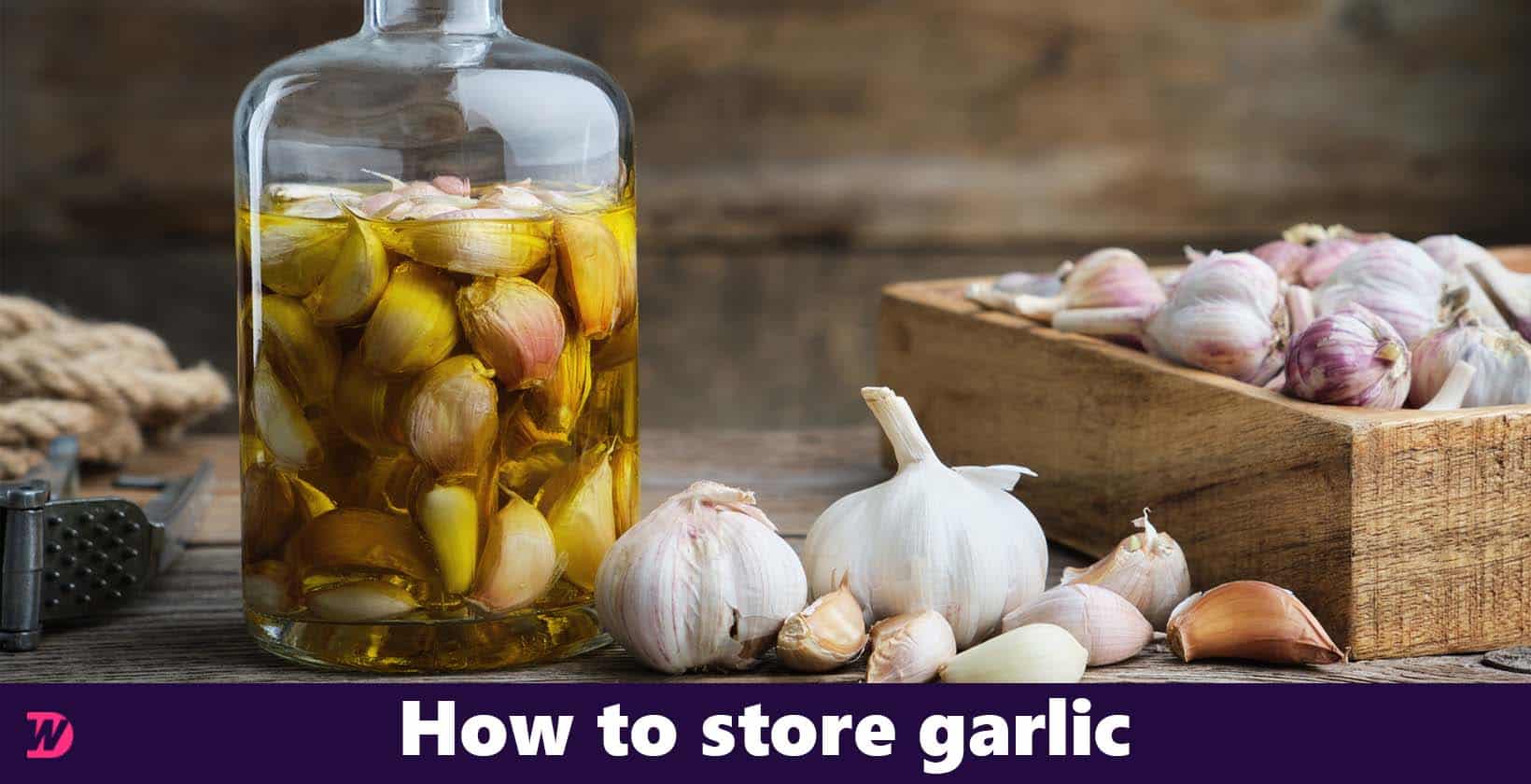Garlic is a popular ingredient in many dishes, providing a burst of flavor while also offering numerous health benefits. Knowing how to store garlic properly is essential in maintaining its freshness, aroma, and potency. When stored incorrectly, garlic can lose its potency, taste, and even develop mold, which can render it inedible.
There are several ways to store garlic, depending on its form and how long you need to store it. Whole bulbs, individual cloves, and peeled cloves each require different methods of storage to ensure they remain fresh and flavorful. By understanding the best storage practices for garlic, you can enjoy its distinctive taste and reap its health benefits for longer periods.
VIEW IN GALLERY
Selecting the Right Garlic
Before thinking about storing garlic, it’s essential to choose the best quality cloves. When selecting garlic at the store or from your garden, inspect the bulbs for any visible signs of damage or decay. A healthy garlic bulb should have tight, firm cloves covered by undamaged, dry outer layers of skin.
Ensure that the garlic bulb is firm and not hollow or soft when lightly squeezed. This indicates that the cloves inside are plump and fresh. Additionally, look for bulbs with unbroken, full skins, as this helps maintain their freshness and flavor for an extended period.
Another important factor when choosing garlic is the size of the cloves. Bigger cloves are not only more convenient to work with but also have a more robust flavor. However, keep in mind that smaller-sized cloves from homegrown or local farmers’ markets may be just as flavorful if not more so, despite their size.
Lastly, consider the variety of garlic. There are two main types: softneck and hardneck. Softneck garlic is more common, has a milder flavor, and stores better than hardneck varieties. Hardneck garlic, on the other hand, has a more potent flavor and shorter shelf life. Choosing the right variety will depend on personal taste preferences and storage requirements.
Signs of Spoiled Garlic
It’s essential to recognize the signs of spoiled garlic to ensure you are using fresh and healthy ingredients in your meals. There are a few telltale signs that your garlic has gone bad.
Firstly, if your garlic cloves have become slimy or mushy to the touch, it is a clear indication that they are no longer fresh. Fresh garlic should have a firm texture.1
Pay attention to the smell of the garlic as well. Spoiled garlic may emit a sour or unpleasant odor that differs from the strong, pungent aroma of fresh garlic.
Another sign of bad garlic is its color. Peeled garlic cloves should be white or slightly off-white. If you notice your garlic cloves turning yellow or developing brown spots, it’s time to discard them2.
Lastly, check for the presence of green sprouts growing from the cloves. While it is not harmful to consume sprouted garlic, it may have a more bitter taste than fresh, unsprouted cloves.
Methods for Storing Garlic
1. At Room Temperature
Store whole heads of garlic in a cool, dry place in a bag or bowl with good airflow, such as a mesh bag or loosely woven basket. Resist the temptation to break the cloves off the bulb until you’re ready to use them, and leave them together, covered in their paper covering. Remember not to store whole garlic bulbs in plastic bags as it prevents air circulation and traps natural moisture, accelerating spoilage.
2. In the Refrigerator
If you must refrigerate garlic, keep it in the main part of your refrigerator rather than in the crisper drawers to ensure it stays fresh. The ideal storage conditions for garlic in the refrigerator are fairly cool, relatively dry, and well-ventilated areas.
3. In the Freezer
To freeze whole garlic heads, place the heads into a freezer-safe bag, label with the date, and freeze . To freeze peeled garlic cloves, peel and separate all cloves, then spread them evenly across a parchment-lined baking sheet. Cover the baking sheet with plastic wrap and freeze overnight.
Below is a table explaining the various methods to store garlic, their pros and cons.
| Garlic Storage | Type of Garlic | Duration | Storage Location | Pros | Cons |
|---|---|---|---|---|---|
| Room Temperature | Whole bulbs | 6-12 months | Cool, dry place with good airflow | Easy access, no extra prep required | Can be affected by humidity and light exposure |
| Refrigeration | Cloves | Up to 3 months | Sealed container in main part of refrigerator | Maintains freshness, prevents sprouting | Can affect flavor and texture |
| Freezing | Whole or peeled cloves | Up to 6 months | Freezer-safe bag or parchment-lined baking sheet | Extends shelf life, retains flavor and nutrients | Requires extra preparation time, can affect texture |
| Storing in oil | Peeled cloves | Up to several months in freezer | Glass jar with tight-fitting lid | Infuses oil with garlic flavor, extends shelf life | Risk of botulism if not stored properly |
How to Store Garlic (Fresh, Cloves, Peeled, Roasted)
How to Store Fresh Garlic
Fresh garlic should be stored in a cool, dry, and dark place with good air circulation. Avoid direct sunlight and high humidity areas to prevent sprouting and mold growth. Storing garlic in a mesh bag or loose basket can help promote air circulation.
Storing Fresh Garlic Step-by-Step Guide
- Choose fresh garlic with firm, dry outer skin.
- Place the garlic in a mesh bag or loose basket.
- Store in a cool, dry, and dark place with good air circulation.
How to Store Garlic Cloves Long Term
To store garlic cloves long term, you can refrigerate them in a sealed container or freeze them. Refrigeration is the best option for separated and peeled garlic cloves, while freezing can work for both peeled and unpeeled cloves.
Storing Garlic Cloves Step-by-Step Guide
- Place peeled or unpeeled garlic cloves in a sealed container for refrigeration or a freezer-safe bag for freezing.
- Label the container or bag with the date.
- Store in the refrigerator or freezer.
How to Store Peeled Garlic
If you have already peeled the garlic cloves, the best way to store them is in the refrigerator. Wrap the cloves in a paper towel or plastic wrap, and place them in an airtight container.
Storing Peeled Garlic Step-by-Step Guide
- Wrap peeled garlic cloves in a paper towel or plastic wrap.
- Place wrapped cloves in an airtight container.
- Store in the refrigerator.
How to Store Roasted Garlic
Roasted garlic can be stored by wrapping it in aluminum foil or placing it in an airtight container. You can refrigerate the roasted garlic for up to a week or freeze it for longer storage.
Storing Roasted Garlic Step-by-Step Guide
- Wrap roasted garlic in aluminum foil or place in an airtight container.
- Refrigerate for up to a week or freeze for longer storage.
- Label with the date if freezing.
Freezing Garlic: Pros and Cons
Freezing garlic is a popular method for preserving its flavor and extending its shelf life. There are different ways to freeze garlic, which have their own unique advantages and drawbacks.
Pros of freezing garlic
- Preserves the garlic for a longer period, preventing waste and allowing you to enjoy garlic throughout the year.
- Garlic retains most of its flavor and nutrients when frozen, making it a suitable option for cooking and seasoning dishes.
- Easily accessible – simply remove the frozen garlic from the freezer and use it in your desired recipe.
- You can freeze both unpeeled whole garlic cloves and chopped garlic, giving you options for storage and future use.
Cons of freezing garlic
- Some people believe that frozen garlic is not as tasty as fresh garlic, potentially affecting the flavor of your dishes.
- Freezing whole garlic is not possible, as it needs to be chopped or peeled prior to freezing, requiring extra preparation time.
- Frozen garlic may lose some of its texture, which could alter the consistency of your recipes.
- Storage space in the freezer becomes limited with the addition of frozen garlic, potentially causing issues for those with limited freezer space.
In summary, freezing garlic can be a practical and effective method for preserving its flavor and nutritional properties, but it’s important to consider the potential drawbacks to ensure it’s the best choice for your needs.
Storing Garlic in Oil
Preserving garlic in oil is an effective storage method that extends the life of the cloves and infuses the oil with their flavor. However, it is crucial to use proper storage techniques to prevent the risk of botulism.
To safely store garlic in oil, start by peeling the cloves without cutting or smashing them, keeping them fully intact. Pour the oil of choice, such as avocado or olive oil, over the cloves until they are submerged. Storing them in a glass jar with a tight-fitting lid is recommended.
Although it is safe to submerge peeled garlic cloves in oil and store them in the freezer for several months, it is not safe to store this mixture at room temperature for more than two hours.
Another option for storing garlic in oil is to finely chop, grate, or press the raw garlic cloves, then place them into ice trays, covering them with oil before freezing. This method allows you to retrieve portioned garlic conveniently when needed.
In summary, while storing garlic in oil offers benefits such as extended shelf life and flavored oil, it is crucial to follow proper storage methods to ensure safety and maintain its quality.
Is Sprouted Garlic Safe to Eat?
Sprouted garlic is a common sight in many kitchens, and many people may wonder if it’s safe to eat. The good news is that sprouted garlic is indeed safe to eat and not dangerous. However, the taste and texture of sprouted garlic may differ from that of regular garlic.
When garlic sprouts, the flavor can become sharper and more bitter. Some people may prefer this taste, while others might not. To get the most out of sprouted garlic, consider removing the green sprout, which is also edible and can be cooked along with the rest of your dish.
Keep in mind that, although it’s safe to consume, sprouted garlic may have a slightly different flavor profile compared to unsprouted garlic. The sprouts can be more bitter and less sweet, which could impact the overall taste of your dish. However, the safety of using sprouted garlic remains the same, and you can still enjoy its health benefits.
Remember to store garlic properly to minimize sprouting, and consider using sprouted garlic in recipes that call for more robust and assertive garlic flavors. As always, make sure to thoroughly clean and prepare your garlic before using it in your dishes.
Factors Affecting Garlic Storage
The longevity and quality of stored garlic depend on several factors. Understanding these factors helps to store garlic effectively and prevent spoilage.
- Temperature: Garlic should be stored at room temperature, as extreme temperatures can affect its shelf life. According to Keene Organics, whole bulbs of garlic can last for 6-12 months or more when stored at room temperature in a dry environment.
- Humidity: Excessive humidity can cause garlic to rot or sprout prematurely. A dry environment is optimal to maintain garlic’s freshness and longevity.
- Air circulation: Adequate air circulation helps to prevent mold and rot from developing on stored garlic. Storing garlic in a mesh bag or an open container allows for proper airflow.
- Light exposure: Direct sunlight can cause garlic to overheat and spoil; it’s important to store garlic away from direct light to prolong its storage life.
- Type of garlic: The variety of garlic also affects its storage life. Garden Betty suggests that softneck garlics are more suitable for braiding, as their stems are more flexible compared to hardneck garlic varieties. This method of storage can help preserve softneck garlic for longer periods.
- Considering these factors ensures proper garlic storage and helps maintain the quality and flavor of this versatile ingredient.



















